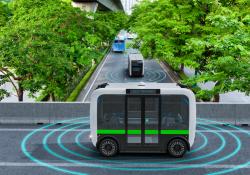RSSElectrification of the automobile is not limited to the electric vehicles (EVs). As a new report from Frost & Sullivan points out, conventional cars of today are partly electric in their own way, with most systems in the vehicle having electrical and electronic connections for better functionality. Certain high-end vehicles possess more than 90 electronic control units (ECUs) to control the various modules within the car, making the car both sophisticated and complicated.
However, added functions such as electric power steering (EPS), electronic braking systems (EBS), GPS-based navigation units, engine management systems etc. make the electrical and electronic (E/E) architecture of the car highly complicated. Future systems are expected to be all the more refined, warranting more ECUs and a much more robust E/E network.
“The car of today has to step-up from a simple 12 Volt on-board power supply to 42V or a proposed 48V power net, in order to support all new systems and applications for enhanced performance, thereby demanding a massive investment across the entire ecosystem,” says Frost & Sullivan industry analyst, Prana Tharthiharan Natarajan. “The benefits of reduced weight of wiring harnesses, more powerful motors for the various motorised applications and high-power ICs do substantiate that the automobile is poised to offer the end-consumer a better experience. But will the benefits also outweigh the costs, is the crucial question.”
Key German auto OEMs1731 BMW, 2069 Daimler and 2125 Audi-1656 Porsche-994 Volkswagen released a joint statement in June 2011, stating that they are keen on introducing a 48V on-board power net as a supplementary power supply for high-power applications such as electric power steering (EPS), brake-by-wire (BBW) and heating, ventilation & air-conditioning (HVAC) systems. Not only is it technically and economically difficult to employ these applications with a standard 12V power net, but it is also increasingly difficult to draw the best performance characteristics with the lack of a high-voltage power net.
On the other hand, not all components and systems designed for the present 12V power-net can be used in the proposed 48V power net. Suppliers are actively working with OEMs in close coordination to develop 48V-specific solutions.
“We expect these innovations to be introduced for power-hungry applications such as EPS, EBS, climate control and electrically powered interior systems such as power-windows, and automatic door-closures,” explains Natarajan.
“The 48V power net is clearly expected to be a step towards creating smarter cars that better utilise the energy available in the vehicle,” believes Mr. Natarajan. “The efforts for introducing the 48V power net lies mainly with the German OEMs mentioned earlier. However, with the entire value chain trying to get ready for this paradigm shift, component manufacturers are holding talks with OEMs from other regions to ensure that the investment reaps sufficient returns to justify the enormous fiscal outlay involved. Sooner or later, many more OEMs are expected to join the bandwagon in implementing a supplementary 48V power net to support the existing 12V power net,” he concludes.
The future is clearly one of split-voltage and direct transition to 48V is not expected to happen in the next decade. The partial step-up to a higher voltage will pave the way for identifying the challenges in completely migrating to a 48V architecture.
However, added functions such as electric power steering (EPS), electronic braking systems (EBS), GPS-based navigation units, engine management systems etc. make the electrical and electronic (E/E) architecture of the car highly complicated. Future systems are expected to be all the more refined, warranting more ECUs and a much more robust E/E network.
“The car of today has to step-up from a simple 12 Volt on-board power supply to 42V or a proposed 48V power net, in order to support all new systems and applications for enhanced performance, thereby demanding a massive investment across the entire ecosystem,” says Frost & Sullivan industry analyst, Prana Tharthiharan Natarajan. “The benefits of reduced weight of wiring harnesses, more powerful motors for the various motorised applications and high-power ICs do substantiate that the automobile is poised to offer the end-consumer a better experience. But will the benefits also outweigh the costs, is the crucial question.”
Key German auto OEMs
On the other hand, not all components and systems designed for the present 12V power-net can be used in the proposed 48V power net. Suppliers are actively working with OEMs in close coordination to develop 48V-specific solutions.
“We expect these innovations to be introduced for power-hungry applications such as EPS, EBS, climate control and electrically powered interior systems such as power-windows, and automatic door-closures,” explains Natarajan.
“The 48V power net is clearly expected to be a step towards creating smarter cars that better utilise the energy available in the vehicle,” believes Mr. Natarajan. “The efforts for introducing the 48V power net lies mainly with the German OEMs mentioned earlier. However, with the entire value chain trying to get ready for this paradigm shift, component manufacturers are holding talks with OEMs from other regions to ensure that the investment reaps sufficient returns to justify the enormous fiscal outlay involved. Sooner or later, many more OEMs are expected to join the bandwagon in implementing a supplementary 48V power net to support the existing 12V power net,” he concludes.
The future is clearly one of split-voltage and direct transition to 48V is not expected to happen in the next decade. The partial step-up to a higher voltage will pave the way for identifying the challenges in completely migrating to a 48V architecture.





